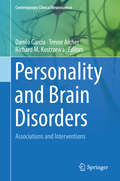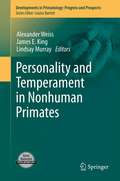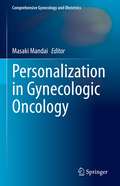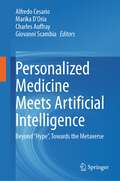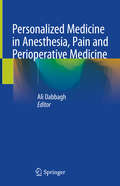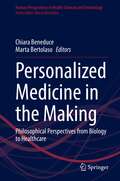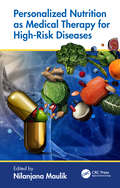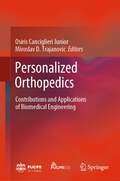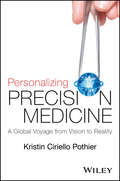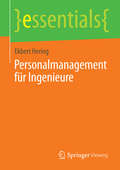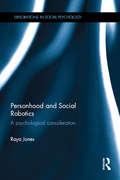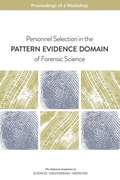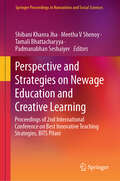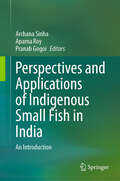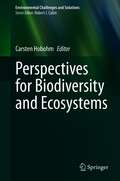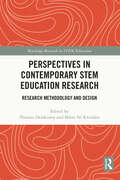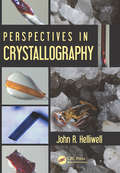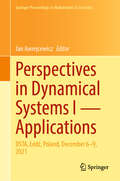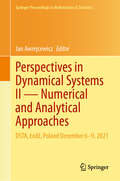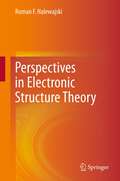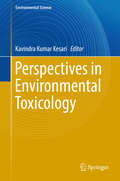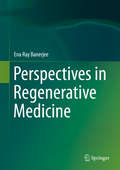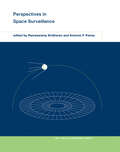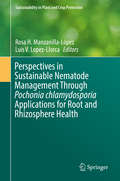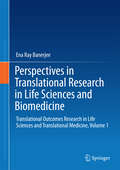- Table View
- List View
Personality and Brain Disorders: Associations and Interventions (Contemporary Clinical Neuroscience)
by Richard M. Kostrzewa Trevor Archer Danilo GarciaBrain disorders (neurodevelopmental, neurodegenerative, and affective disorders) can be investigated, treated, and prevented using person-centered methods. Because researchers have not reached a clear consensus on whether or not personality is stable or changeable, it has been difficult to outline how to use these methods in the care of people with brain disorders. Thus, the first part aims to identify the ways in which brain disorders and personality are linked. The second part explores different person-centered approaches that can be incorporated in a healthcare or education setting to help people with various brain disorders and to promote physical, mental and social health. The third part focuses on challenges and new venues.
Personality and Temperament in Nonhuman Primates
by Alexander Weiss James E. King Lindsay MurrayRecently, there has been an increased interest in research on personality, temperament, and behavioral syndromes (henceforth to be referred to as personality) in nonhuman primates and other animals. This follows, in part, from a general interest in the subject matter and the realization that individual differences, once consigned to 'error' terms in statistical analyses, are potentially important predictors, moderators, and mediators of a wide variety of outcomes ranging from the results of experiments to health to enrichment programs. Unfortunately, while there is a burgeoning interest in the subject matter, findings have been reported in a diverse number of journals and most of the methodological and statistical approaches were developed in research on human personality. The proposed volume seeks to gather submissions from a variety of specialists in research on individual differences in primate temperament, personality, or behavioral syndromes. We anticipate that chapters will cover several areas. The first part of this edited volume will focus on methodological considerations including the advantages and disadvantages of different means of assessing these constructs in primates and introduce some statistical approaches that have typically been the domain of human personality research. Another part of this edited volume will focus on present findings including the physiological and genetic bases of personality dimensions in primates; the relationship between personality and age; how personality may moderate or impact various outcomes including behavior, health, and well-being in captive and non-captive environments. For the third part of the volume we hope to obtain summaries of the existing work of the authors on the evolutionary important of personality dimensions and guideposts for future directions in this new and exciting area of research.
Personalization in Gynecologic Oncology (Comprehensive Gynecology and Obstetrics)
by Masaki MandaiThis book thoroughly illustrates the designed and tailored medical approaches for tumors of the female reproductive organ. The chapters explore different cancer species such as ovarian cancer, endometrial cancer, cervical cancer, etc. Various treatment modalities such as immunotherapy and histotype-specific treatment are delivered, and it offers a chapter on how genome-wide analysis contributes to personalized treatment. It is essential to understand this concept because many molecular target drugs and the prevalence of genome-based analysis in clinical settings have enabled us to introduce valid precision medicine in the field of gynecologic oncology. Chapters explain the stream of transition from conventional standardized treatment to personalized treatment and address future perspectives.Personalization Gynecologic Oncology is a well-designed source for beginning to advanced oncologists, gynecologists, geneticists, genetic counselors, and nurses. Offering the latest treatment strategies, the Editor hopes the ideas presented here will be a foundation for further development in the field.
Personalized Medicine Meets Artificial Intelligence: Beyond “Hype”, Towards the Metaverse
by Alfredo Cesario Marika D’Oria Charles Auffray Giovanni ScambiaThe book provides a multidisciplinary outlook on using Artificial Intelligence (AI)-based solutions in the field of Personalized Medicine and its transitioning towards Personalized Digital Medicine.The first section integrates different perspectives on AI-based solutions and highlights their potential in biomedical research and patient care. In the second section, the authors present several real-world examples that demonstrate the successful use of AI technologies in various contexts. These include examples from digital therapeutics, in silico clinical trials, and network pharmacology. In the final section of the book, the authors explore future directions in AI-enhanced biomedical technologies and discuss emerging technologies such as blockchain, quantum computing and the “metaverse”. The book includes discussions on the ethical, regulatory, and social implications for an AI-based personalized medicine. The integration of heterogeneous disciplines brings together multiple stakeholders and decision makers involved in the personalization of care. Clinicians, students, and researchers from academia and the industry can benefit from this book, since it provides foundational knowledge to drive advances in personalized biomedical research and health care.
Personalized Medicine in Anesthesia, Pain and Perioperative Medicine
by Ali DabbaghThis book discusses the current and future impact of cellular and molecular medicine (CMM) on anesthesiology and perioperative medicine. It covers the topic from a translational perspective and describes the relevance of CMM to daily clinical practice. Taking a bench-to-bedside approach, chapters examine topics including perioperative acute and chronic management, perioperative organ protection, and novel pharmaceuticals. Personalized Medicine in Anesthesia, Pain and Perioperative Medicine is aimed at anesthesiologists and pain physicians, and will also be of interest to pharmacists and those working in cellular and molecular medicine.
Personalized Medicine in the Making: Philosophical Perspectives from Biology to Healthcare (Human Perspectives in Health Sciences and Technology #3)
by Marta Bertolaso Chiara BeneduceThis book offers a multidisciplinary look at the much-debated concept of “personalized medicine”. By combining a humanistic and a scientific approach, the book builds up a multidimensional way to understand the limits and potentialities of a personalized approach in medicine and healthcare. The book reflects on personalized medicine and complex diseases, the relationship between personalized medicine and the new bio-technologies, personalized medicine and personalized nutrition, and on some ethical, political, economic, and social implications of personalized medicine. This volume is of interest to researchers from several disciplines including philosophy, bio-medicine, and the social sciences.
Personalized Nutrition as Medical Therapy for High-Risk Diseases
by Nilanjana MaulikPersonalized nutrition involves the formulation of individualized nutritional recommendations to promote and maintain health based on an individual's genetic makeup and other unique intrinsic and extrinsic factors. Implementing personalized nutrition plans for individuals with certain diseases or who are in danger of developing health conditions could help control the onset and severity of symptoms. Personalized Nutrition as Medical Therapy for High-Risk Diseases offers a practical guide for physicians seeking to provide tailored dietary recommendations to their patients with disease treatment, modulation and prevention in mind. The book focuses on the biological mechanisms of specific diseases and provides evidence for how personalized nutrition positively impacts them. It explores conditions including cardiovascular diseases, hypertension, hypercholesteromia, diabetes, obesity, Crohn's disease, as well as multiple pediatric, renal and psychological disorders. Features: · Includes case studies that document how people respond differently towards food depending on their genetic structure and other factors. · Discusses genome wide association studies (GWIMS) to understand the interplay between genetic susceptibility and dietary interactions. · Provides users information to effectively implement personalized nutrition into practice. · Identifies possible challenges to the implementation of personalized nutritional interventions in a clinical setting. This book is for medical practitioners and will also appeal to researchers and students.
Personalized Orthopedics: Contributions and Applications of Biomedical Engineering
by Osiris Canciglieri Junior Miroslav D. TrajanovicThis book covers the most important topics in the field of personalized orthopedics. It starts with the 3D geometry of the bones, focusing on the problem of reverse engineering of the bones. It also shows the application of a 3D geometric model of bone for the design of personalized implants and prostheses. This book covers the application of additive technologies in personalized orthopedics as well as prediction, simulation and optimization in personalized orthopedics. Its content provides the necessary knowledge for the transition from classical to personalized orthopedics. The authors present an original method for reverse bone engineering—the Method of Anatomical Features (MAF). This method is unique as it enables the reconstruction of the original geometry and topology of the bone, even when only data on its part are available. The application of this method is shown on the examples of human long bones, mandible and hip bone reconstruction. This book contains a review of several real cases of personalized implants. It gives several examples of prostheses for the design of which a 3D model of bones was used, as well as other patient data on the basis of which personalized prostheses were designed.
Personalizing Precision Medicine: A Global Voyage from Vision to Reality
by Kristin Ciriello PothierThe author uses decades of experience and interviews with experts in precision medicine to explain past, present, and future of precision medicine. She reviews the full continuum of personalizing precision medicine, including diagnostics, therapeutics, big data, supportive care, regulation, and reimbursement and innovation in precision medicine worldwide.• Combines a unique cross section of history, current technologies, and future directions for how precision medicine has and will affect people worldwide• Reviews precision medicine around the world, including the US, China, Japan, the Middle East, India, Europe, and Latin America• Discusses a number of diseases areas – cancer, cardiovascular, neurodegenerative, infectious disease, pain, immunology, rare diseases• Includes information and quotes from over 100 interviews with key industry experts in biotech, pharma, informatics, diagnostics, health providers, advocacy groups, and more.• Includes stories illustrating current issues and future promises in precision medicine for a human touch
Personalmanagement für Ingenieure (essentials)
by Ekbert HeringMitarbeiter sind die wichtigste Ressource eines Unternehmens. Geeignetes Personal zu finden und an das Unternehmen zu binden, gehört daher zu den wichtigsten und erfolgsentscheidenden Aufgaben im Unternehmen. Gerade Ingenieure übernehmen im Laufe ihrer Karriere immer mehr Personalverantwortung. Deshalb sind die Kenntnisse über Personalmanagement für Ingenieure sehr wichtig. Im Mittelpunkt steht dabei die Persönlichkeit eines Menschen. Anhand des Verhaltensmodells nach persolog® werden verschiedene Persönlichkeitsprofile aufgezeigt sowie deren Stärken und Schwächen vorgestellt (beispielsweise für Konstrukteure oder Innovatoren). Wichtig ist dabei, dass die Mitarbeiter entsprechend ihren Stärken richtig eingesetzt werden. Ausführlich werden die Methoden der Personalfindung, der Personalbindung, der Mitarbeiterbeurteilung und Entlohnung sowie der Personaltrennung behandelt.
Personhood and Social Robotics: A psychological consideration (Explorations in Social Psychology)
by Raya A JonesAn exponentially growing industry, human robot interaction (HRI) research has drawn predominantly upon psychologists’ descriptions of mechanisms of face-to-face dyadic interactions. This book considers how social robotics is beginning unwittingly to confront an impasse that has been a perennial dilemma for psychology, associated with the historical ‘science vs. art’ debate. Raya Jones examines these paradigmatic tensions, and, in tandem, considers ways in which the technology-centred discourse both reflects and impacts upon understanding our relational nature. Chapters in the book explore not only how the technology-centred discourse constructs machines as us, but also how humans feature in this discourse. Focusing on how the social interaction is conceptualised when the human-robot interaction is discussed, this book addresses issues such as the long-term impact on persons and society, authenticity of relationships, and challenges to notions of personhood. By leaving aside terminological issues, Jones attempts to transcend ritual of pitching theories against each other in order to comprehensively analyse terms such as subjectivity, self and personhood and their fluid interplay in the world that we inhabit. Personhood and Social Robotics will be a key text for postgraduate students, researchers and scholars interested in the connection between technology and human psychology, including psychologists, science and technology studies scholars, media studies scholars and humanists. The book will also be of interest to roboticists and HRI researchers, as well as those studying or working in areas of artificial intelligence and interactive technologies more generally.
Personnel Selection in the Pattern Evidence Domain of Forensic Science: Proceedings of a Workshop
by Engineering Medicine National Academies of SciencesIn July 2016 The National Academies of Sciences, Engineering, and Medicine convened a workshop with the goal of bringing together industrial and organizational (I-O) psychologists, experts on personnel selection and testing, forensic scientists, and other researchers whose work has a nexus with workforce needs in the forensic science field with a focus on pattern evidence. Participants reviewed the current status of selection and training of forensic scientists who specialize in pattern evidence and discussed how tools used in I-O psychology to understand elements of a task and measure aptitude and performance could address challenges in the pattern evidence domain of the forensic sciences. This publication summarizes the presentations and discussions from the workshop.
Perspective and Strategies on Newage Education and Creative Learning: Proceedings of 2nd International Conference on Best Innovative Teaching Strategies, BITS Pilani (Springer Proceedings in Humanities and Social Sciences)
by Shibani Khanra Jha Meetha V Shenoy Tamali Bhattacharyya Padmanabhan SeshaiyerThis book presents the proceedings of the International Conference on Best Innovative Teaching Strategies (ICOBITS) at BITS Pilani on Feb 9-11, 2023. It brings together global academicians, researchers, and industry experts to delve into innovative teaching-learning practices. Meticulously selected and reviewed by professionals, the proceedings offer cross-cutting perspectives and strategies in education and creative learning. It is organized into four parts and covers Innovative Pedagogical Practices for Technology Enhanced Learning, Technology, Society and Industry in Higher Education, STEM Education and Cultural Studies, Gender Studies and Sustainability in Higher Education. It provides insights into assessment tools for effectively evaluating the efficiency of teaching methods. Part one explores ICT, digital classrooms, metaverse-based teaching, gamification, and AI-ML-based practices. Part two delves into the humanistic approach in technical education, social networking as an educational tool, and outcome-based assessment needs. Part three addresses future educators' requirements through multidisciplinary collaboration in STEM education. Part four discusses gender equity, structured social inclusion and cultural skills in teaching-learning practices. This book is a valuable resource for academicians, researchers, policymakers, administrators, technocrats, and developers actively engaged in education technology across disciplines such as Engineering, Sciences, Management, Humanities, and Social Sciences.
Perspectives and Applications of Indigenous Small Fish in India: An Introduction
by Archana Sinha Aparna Roy Pranab GogoiThis contributed volume covers all aspects of small indigenous fish for nutritional and livelihood security. The availability, descriptions and identification of common small indigenous fish provides potential and prospects of fish production from inland open water system. In addition, individual chapters are added on growth, feeding, diseases and health management of these small fishes. Essential information is provided on packaging and transport of these fishes. Specific chapters provide information on nutritional value of fishes, value addition and product development by using small indigenous fish species in different regions of the country. Further topics include small fishes of ornamental value, indigenous technical knowledge, climate change impact, conservation and management of small indigenous fish diversity. This book supports the academicians, farmers, entrepreneurs and fisheries professionals involved in gaining the knowledge and skills needed to contribute in nutritional and livelihood security of the nation.
Perspectives for Biodiversity and Ecosystems (Environmental Challenges and Solutions)
by Carsten HobohmThe novelty of the book is a strong focus on perception, perspectives and prediction by scientists with profound insight into the ecology of ecosystems or into human demands and activity. The challenge is to bridge from empirical data and the knowledge of the past to the possibilities of the performance in the future. We assume that there is scope for more cooperation between the fields of ecology and practical philosophy or other social sciences in organising ecosystems and shaping the cultural future of humankind, and that such collaboration should be accorded considerably more priority. This book deals with environmental processes seen within a framework of the nature of ecosystems and human cultures. The future of the environment, the development of ecosystems and effective nature conservation management are the essentials of this book. Human nature and culture, and in particular their interactions, are interpreted as a set of rules and as given. The aim is not only to assess the significance of human influence on species composition and biodiversity but also to weigh up the subsequent potentials for action. In this book we will analyze the problems independently of one another, even if they are interconnected. This book focuses on perspectives and prognoses for the impacts of anthropogenic activity on ecosystems and thus on species conservation. Its goal is to improve assessments of the impacts of human activity on the environment. We are aware that prognoses have very often proven to be false. It is difficult to impossible to be able to predict with precision how evolution and ecosystems will change in future under anthropogenic influence. This strengthens our resolve to attempt to retain the highest possible degree of scientific integrity and professionalism and not to shy away from expressing the uncertainty of our own ideas and prognoses. We venture prognoses in this book and we will fail. However, we hope that we will be wrong on the right side.
Perspectives in Contemporary STEM Education Research: Research Methodology and Design (Routledge Research in STEM Education)
by Thomas Delahunty Máire Ní RíordáinThis book presents an overview of the methodological innovations and developments present in the field of STEM education research as well as providing a practically orientated resource on research method design more broadly. Featuring a range of international contributors in the field, the book provides a compendium of exemplary innovative methodological designs, implementations, and analyses that answer a variety of research questions relating to STEM education disciplines. Charting the thinking behind the design and implementation of successful research investigations, the book’s two parts present an accessible and pragmatically framed set of chapters that cover a range of important methodological areas presented by active researchers in the field. Ultimately, this book presents a comprehensive resource that explores the act of educational research as related to STEM. By showcasing key methodological principles with guidance on practical approaches underpinned by theory, the book offers scholarly research-informed suggestions for practice. It will be of great interest to researchers, academics, and students in the fields of STEM education and education research methods, as well as educational research more broadly.
Perspectives in Crystallography
by John R. HelliwellCrystallography is one of the most multidisciplinary sciences, with roots in fields as varied as mathematics, physics, chemistry, biology, materials science, computation and earth and planetary science. The structural knowledge gained from crystallography has been instrumental in acquiring new levels of understanding in numerous scientific areas. P
Perspectives in Dynamical Systems I — Applications: DSTA, Łódź, Poland, December 6–9, 2021 (Springer Proceedings in Mathematics & Statistics #453)
by Jan AwrejcewiczThis proceedings volume gathers selected, peer-reviewed papers presented at the Dynamical Systems Theory and Applications International Conference - DSTA 2021, held virtually on December 6-9, 2021, organized by the Department of Automation, Biomechanics, and Mechatronics at Lodz University of Technology, Poland. This volume concentrates on studies on applications, while Volume II focuses on numerical and analytical approaches.Being a truly international conference, this 16th iteration of DSTA received submissions from authors representing 52 countries. The program covered both theoretical and experimental approaches to widely understood dynamical systems, including topics devoted to bifurcations and chaos, control in dynamical systems, asymptotic methods in nonlinear dynamics, stability of dynamical systems, lumped mass and continuous systems vibrations, original numerical methods of vibration analysis, nonsmooth systems, dynamics in life sciences and bioengineering, as well as engineering systems and differential equations.DSTA conferences aim to provide a common platform for exchanging new ideas and results of recent research in scientific and technological advances in modern dynamical systems. Works contained in this volume can appeal to researchers in the field, whether in mathematics or applied sciences, and practitioners in myriad industries.
Perspectives in Dynamical Systems II — Numerical and Analytical Approaches: DSTA, Łódź, Poland December 6–9, 2021 (Springer Proceedings in Mathematics & Statistics #454)
by Jan AwrejcewiczThis proceedings volume gathers selected, peer-reviewed papers presented at the Dynamical Systems Theory and Applications International Conference - DSTA 2021, held virtually on December 6-9, 2021, organized by the Department of Automation, Biomechanics, and Mechatronics at Lodz University of Technology, Poland. This volume focuses on numerical and analytical approaches, while Volume I concentrates on studies on applications.Being a truly international conference, this 16th iteration of DSTA received submissions from authors representing 52 countries. The program covered both theoretical and experimental approaches to widely understood dynamical systems, including topics devoted to bifurcations and chaos, control in dynamical systems, asymptotic methods in nonlinear dynamics, stability of dynamical systems, lumped mass and continuous systems vibrations, original numerical methods of vibration analysis, non-smooth systems, dynamics in life sciences and bioengineering, as well as engineering systems and differential equations.DSTA conferences aim to provide a common platform for exchanging new ideas and results of recent research in scientific and technological advances in modern dynamical systems. Works contained in this volume can appeal to researchers in the field, whether in mathematics or applied sciences, and practitioners in myriad industries.
Perspectives in Electronic Structure Theory
by Roman F. NalewajskiThe understanding in science implies insights from several different points of view. Alternative modern outlooks on electronic structure of atoms and molecules, all rooted in quantum mechanics, are presented in a single text. Together these complementary perspectives provide a deeper understanding of the localization of electrons and bonds, the origins of chemical interaction and reactivity behavior, the interaction between the geometric and electronic structure of molecules, etc. In the opening two parts the basic principles and techniques of the contemporary computational and conceptual quantum chemistry are presented, within both the wave-function and electron-density theories. This background material is followed by a discussion of chemical concepts, including stages of the bond-formation processes, chemical valence and bond-multiplicity indices, the hardness/softness descriptors of molecules and reactants, and general chemical reactivity/stability principles. The insights from Information Theory, the basic elements of which are briefly introduced, including the entropic origins and Orbital Communication Theory of the chemical bond, are the subject of Part IV. The importance of the non-additive (interference) information tools in exploring patterns of chemical bonds and their covalent and ionic components will be emphasized.
Perspectives in Environmental Toxicology
by Kavindra Kumar KesariThis book is a valuable contribution to the debate about the harmful effects of environmental toxicants on human health, which is a growing concern in the 21st century. Complementary chapters decipher the phenomena and highlight the latest developments in environmental toxicology, providing readers with a comprehensive overview of environmental toxicology and human health.Since the toxicants in question are not only chemical or biological in nature, but also include man-made electromagnetic fields, the book explores in detail multidisciplinary approaches to environmental toxicology, with a focus on the following five aspects: 1. The effects of man-made electromagnetic fields (RF-EMF) on human health proposed mechanisms and biological effects and measures). 2. An overview of nanotoxicity, nanomedicine and cancer research. 3. A bio-computational approach to the molecular interaction of environmental carcinogens with DNA. 4. The toxicology of environmental pollutants in the air, dust, soil, water and natural toxins in the environment: exposure and health. 5. Social insects as environmental indicators of ecotoxicological effects in different ecosystems.The book analyzes the carcinogenic, mutagenic, genotoxic and neurotoxic effects of both anthropogenic and natural toxins present in water, soil, air and our surroundings in the form of electro-pollution or electro-smog.
Perspectives in Regenerative Medicine
by Ena Ray BanerjeeThe information given in this book tries to capture the essence of the sheer dynamicity of the cell along with useful tips on how to address critical rate limiting steps in the process of exploration and investigation of its capacity to regenerate, rebuild and replenish from within. The definitions of stem cells, stemness, and the niche concept continue to undergo revisions. In adult vertebrates, hematopoietic and some non-hematopoietic progenitors are synthesized within specialized niches of bone marrow. They migrate to designated tissues, and are either trans-differentiated or become quiescent and settle down. These form the stem cell niche reservoir in all tissues. Not only the primary hematopoietic tissue but all organs and tissues are also capable of generating progenitors which are either synthesized from these migrants or are direct recruits from other tissues. In the niches, the cells settle down and await their turn to either make more clones like themselves or differentiate and mobilize in an exigency. Thus progenitors are important reserves, to be multiplied and deployed or travel as important message bearing molecules via blood as circulating progenitors which can home to their allocated destinations. Upon reaching, specific integrins and selectins help them "dock" and "port" and they may be reprogrammed to induce further differentiation and help repopulate the denuded tissue. In pulmonary fibrosis and asthma, progenitors from both systemic circulation and local stem cell niches have been found to participate in the myriad ramifications of repair, replacement and regeneration of lost or diseased tissue. Whether they are lung specific or global in origin and role remain to be explored. Research tools, fundamental concepts, techniques, methodologies and standard operating protocols and animal models and human extrapolations, have been discussed in a concise way along with detailed description and discussion on the appropriate rationale to introduce the subject to the casual reader and provide valuable tactical information to the specialist in Regenerative Medicine. I sincerely hope you enjoy the work and appreciate the hard work that has gone into designing and executing elegant experiments by many researchers in the field. The branch is multi-disciplinary and I hope that the readers will not be limited to biologists alone.
Perspectives in Space Surveillance (MIT Lincoln Laboratory Series)
by Ramaswamy Sridharan Antonio PensaThe development of deep space surveillance technology and its later application to near-Earth surveillance, covering work at Lincoln Laboratory from 1970 to 2000.In the 1950s, the United States and the Soviet Union raced to develop space-based intelligence gathering capability. The Soviets succeeded first, with SPUTNIK I in 1957. The United States began to monitor the growing Soviet space presence by developing technology for the detection and tracking of man-made resident space objects (RSOs) in near-Earth orbit. In 1972, the Soviet Union launched a satellite into deep space orbit, and the U.S. government called on MIT Lincoln Laboratory to develop deep space surveillance technology. This book describes these developments, as well as the later application of deep space surveillance technology to near-Earth surveillance, covering work at Lincoln Laboratory on space surveillance from 1970 to 2000.The contributors, all key participants in developing these technologies, discuss topics that include narrow beam, narrow bandwidth radar for deep surveillance; wide bandwidth radar for RSO monitoring; ground-based electro-optical deep space surveillance and its adaptation for space-based surveillance; radar as the means of real-time search and discovery techniques; methods of analyses of signature data from narrow bandwidth radars; and the collision hazard for satellites in geosynchronous orbit, stemming initially from the failure of TELSTAR 401. They also describe some unintended byproducts of this pioneering work, including the use of optical space surveillance techniques for near-Earth asteroid detection. ContributorsRick Abbott, Robert Bergemann, E.M. Gaposchkin, Israel Kupiec, Richard Lambour, Antonio F. Pensa, Eugene Rork, Jayant Sharma, Craig Solodyna, Ramaswamy Sridharan, J. Scott Stuart, George Zollinger
Perspectives in Sustainable Nematode Management Through Pochonia chlamydosporia Applications for Root and Rhizosphere Health
by Rosa H. Manzanilla-López Luis V. Lopez-LlorcaThis volume reviews our current knowledge and novel research areas on Pochonia chlamydosporia, a cosmopolitan fungus occurring in soils as a saprophyte yet capable of colonizing the rhizosphere of crops as an endophyte and behaving as a parasite of eggs of plant-parasitic nematodes. The book is divided into six sections containing 18 chapters, starting with a historical background chapter, followed by 16 chapters, each contributed by experts, concerning those key aspects necessary to work with this biocontrol agent in a multidisciplinary treatise. Topics covered include systematics, biology, nematode-fungus interactions, nematode management strategies, secondary metabolites, and other methods including more novel research areas such as molecular, –omics, plant growth enhancement and endophytic abilities of P. chlamydosporia. The final chapter deals with the future perspectives of P. chlamydosporia research.
Perspectives in Translational Research in Life Sciences and Biomedicine
by Ena Ray BanerjeeThe present book addresses the multi-disciplinary nature of Translational Outcomes Research, which is a watershed for nearly all the disciplines of Life and Health Sciences, along with the Materials Sciences including but not limited to Zoology, Botany, Microbiology, Biochemistry, Physiology, Nanotechnology, the Medical Sciences, Bioengineering, Biophysics, Medicinal Chemistry, Structural Biology, Biostatistics and Bioinformatics. This book, for the first time, addresses the basic premises of fundamental research in facilitating drug discovery. One chapter is dedicated to a novel generation of platforms with novel camelid antibodies and their technological extensions, while another focuses on functional food and nutraceuticals. The book begins with a thorough overview of what translational outcomes research connotes and what the current status of research in the area is, and goes on to elucidate various pertinent preclinical disease models and their uses in basic and application based research in the Life Sciences. How basic approaches to screening and characterization vis-à-vis their role in amelioration of the two cardinal problems of inflammation and degeneration involved in most diseases is elucidated. The book ends with a discussion of the relevance and importance of using Bio Green technology in Translational Outcomes, addressing the need to fill the gap between academia and industry and clinics that can arise through direct or indirect collaboration between the stakeholders and emphasizing the need for an eco-friendly approach so as not to jeopardize the fine balance that holds life on earth in harmony.
